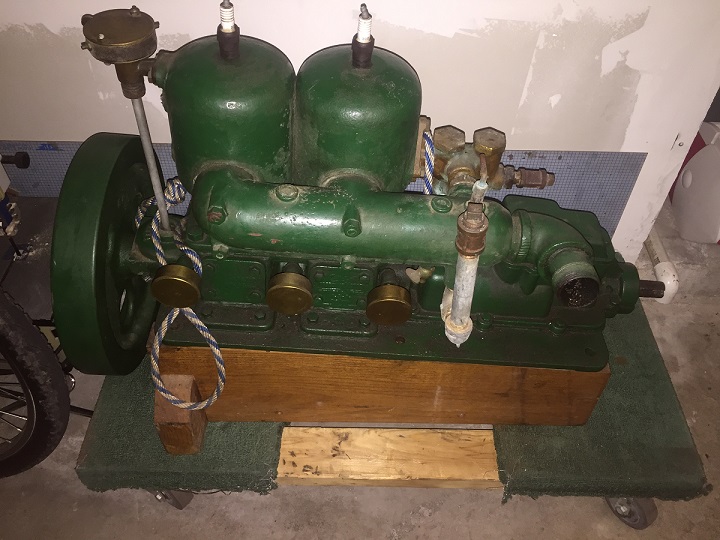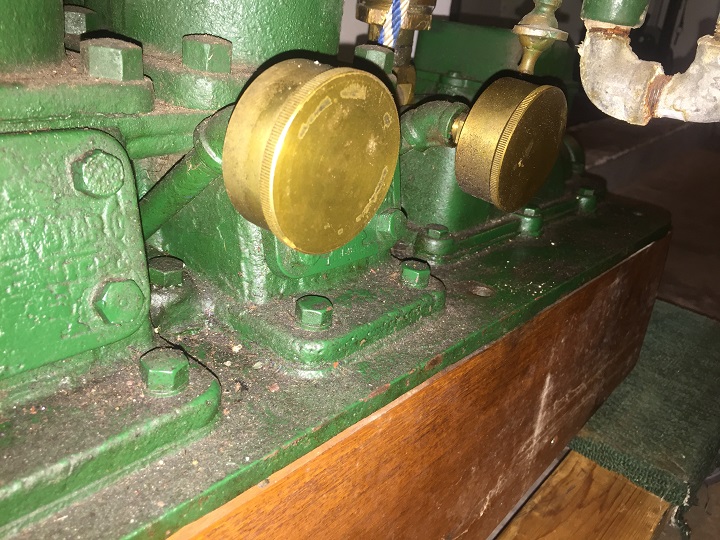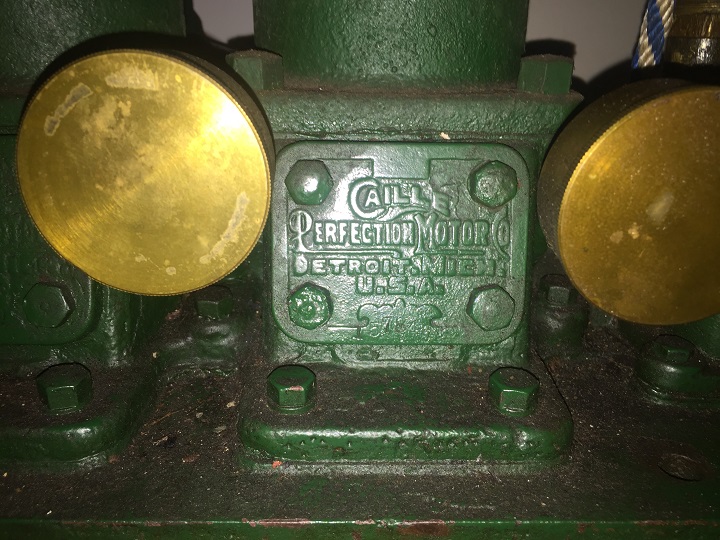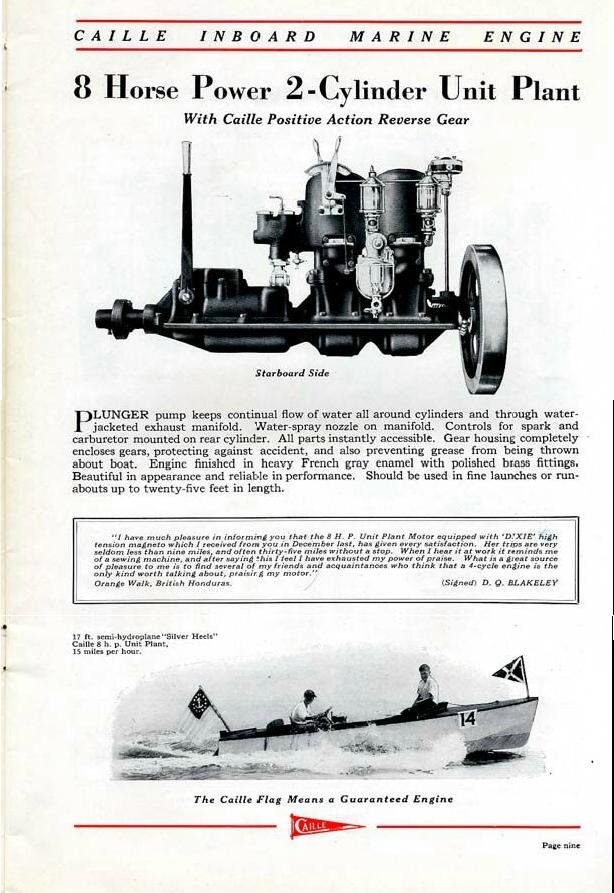| Author |
Message |
    
telstar
New member
Username: telstar
Post Number: 1
Registered: 01-2019
| | Posted on Wednesday, January 02, 2019 - 08:28 pm: | 




|
Hello!
I am new to this forum and new to antique marine engines.. I was hoping to find out more about my recent purchase, a Caille Twin. The number on the inspection cover is 15784. Is there a way to date these engines?
Also it is missing the Shebler carburetor so I am unsure how to locate the correct one for this engine.
It appears to have excellent compression so I hope to having running again some day in the future.
Thanks in advance!
Sean
   |
    
miro
Senior Member
Username: miro
Post Number: 1018
Registered: 11-2001

| | Posted on Friday, January 04, 2019 - 11:26 pm: | 




|
Nice find - good for you and welcome to the OME group.
The carb is probably a 1 inch Schebler - they are quite common and were used by many builders of marine engines - mainly because they were good and not expensive.A picture of the intake side of the engine will help.
Do you know if the engine was run in salt water? If yes, please don't let it dry out - many folks use antifreeze to prevent drying.
Here's the link to one of the best explanations.
http://www.oldmarineengine.com/technical/corrosion_1.html
For ignition, I suggest the modern version of the buzz coil- inexpensive and you can probably make your own and put it in a nice "olde" wooden box.
Miro |
    
jb_castagnos
Senior Member
Username: jb_castagnos
Post Number: 1404
Registered: 07-2002

| | Posted on Sunday, January 06, 2019 - 06:53 pm: | 




|
That's a very complete engine, nice. I have two similar, don't know how to date them. Remove the pug in the water outlet, if the water can't get out something is going to give. |
    
johnny
Senior Member
Username: johnny
Post Number: 592
Registered: 03-2006

| | Posted on Sunday, January 06, 2019 - 07:22 pm: | 




|
Caille 8hp twin page is from a 1922 catalog from Jack Craib's caille website.
Carb you need is a Schebler model "D", 1"-11&1/2 NPT, with slide valve throttle control.
 |
    
jb_castagnos
Senior Member
Username: jb_castagnos
Post Number: 1405
Registered: 07-2002

| | Posted on Monday, January 07, 2019 - 09:02 am: | 




|
Looks like a cast iron water pump in the ad. I read that they switched to cast iron in WWI because brass was in short supply. Any evidence of this? |
    
johnny
Senior Member
Username: johnny
Post Number: 594
Registered: 03-2006

| | Posted on Monday, January 07, 2019 - 03:15 pm: | 




|
JB, Seems like I recall seeing something either on a price list or parts list for the Detroit Engine Works that the cast iron water pumps were used mostly for fresh water and the bronze pumps for salt water. Bronze pump was like a option, more expensive option. Don't know about the WWI deal but makes sense.
Sean, I meant to welcome you to the forum in my first reply but it slipped my mind as I was posting info. |
    
telstar
New member
Username: telstar
Post Number: 2
Registered: 01-2019
| | Posted on Tuesday, January 08, 2019 - 06:10 pm: | 




|
Thanks to all for the helpful information, links, and articles! And having a model number for the carb will save me time. Thanks, Johnny!
Miro, unfortunately I don't know for certain if the engine was run in salt water but, I just cracked open the plugs and green fluid flowed out so it appears it was preserved before put away.
I'd also like to confirm the correct spark plug. It came with 2 Autolite 3095 plugs.
Many thanks!
Sean |
    
johnny
Senior Member
Username: johnny
Post Number: 595
Registered: 03-2006

| | Posted on Wednesday, January 09, 2019 - 07:02 pm: | 




|
A tip about using Antifreeze in your antique engines:
I do not leave antifreeze in any of my engines more then one season and here is why. I have two stationary engines I purchased from a widow lady. Husband and her were friends of mine and members of our antique engine club. When he passed away she did nothing with his engines for about a year or two. The engines just set inside the barn. She finally decided to sell them and I purchased a few of the engines from her. Her husband had about a dozen of the old engines and always kept antifreeze in them. The piston on two of the engines were stuck hard. When we started looking closer at the engines we discovered that the water had evaporated from the antifreeze and corroded really bad. On one engine the drip oiler pipe that went down through the water hopper and threaded into the cylinder was corroded all the way through and the oiler & pipe had fell down in the antifreeze. The antifreeze went down through what little bit of pipe that was still sticking up on the cylinder and that's why the piston was stuck hard. The other engine the antifreeze had corroded a small pin hole in the water hopper through the cylinder and antifreeze got into the cylinder and piston and it was also stuck hard. Antifreeze is highly corrosive with out water. So if you use antifreeze you might want to keep it changed out yearly to the correct mixture.
Sean, On your Callie I think JB might be talking about that small pipe that comes out of the bottom of the exhaust manifold goes down and then does a couple 90's back up. It appears to have white corrosion and rust around those pipes. The pipes and maybe the manifold may have water still in it causing corrosion. Might want to check it out, take plug out. Maybe open up the drain valve on the bottom of the exhaust manifolds. I guess it could be possible that someone filled it all up with water/antifreeze and closed everything off. Could have been a salt water engine. |


